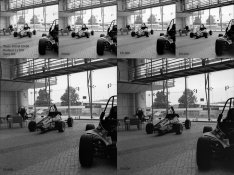jsimoespedro
Member
- Joined
- Oct 26, 2012
- Messages
- 61
- Format
- Medium Format
Hi all,
Here goes an example of what you can get from Tmax400 when shot at EI800, 1600 and 3200.
The shots were metered off the center car.
Developed in Rodinal 1+100 for 60 minutes with agitation at 20 and 40 minutes.
In the top row, only levels were adjusted to obtain same black and white points are approximately the same mid-tone.
On bottom row, processed to taste.
http://www.flickr.com/photos/90448738@N05/11935855125/in/photostream/
400, 800 are very close. 3200 shot returns very poor shadows. EI1600 is probably the maximum to get from TMax400 using Rodinal and Std development.
I also have over exposed shots (50-200) will post when I can.
Here goes an example of what you can get from Tmax400 when shot at EI800, 1600 and 3200.
The shots were metered off the center car.
Developed in Rodinal 1+100 for 60 minutes with agitation at 20 and 40 minutes.
In the top row, only levels were adjusted to obtain same black and white points are approximately the same mid-tone.
On bottom row, processed to taste.
http://www.flickr.com/photos/90448738@N05/11935855125/in/photostream/
400, 800 are very close. 3200 shot returns very poor shadows. EI1600 is probably the maximum to get from TMax400 using Rodinal and Std development.
I also have over exposed shots (50-200) will post when I can.













